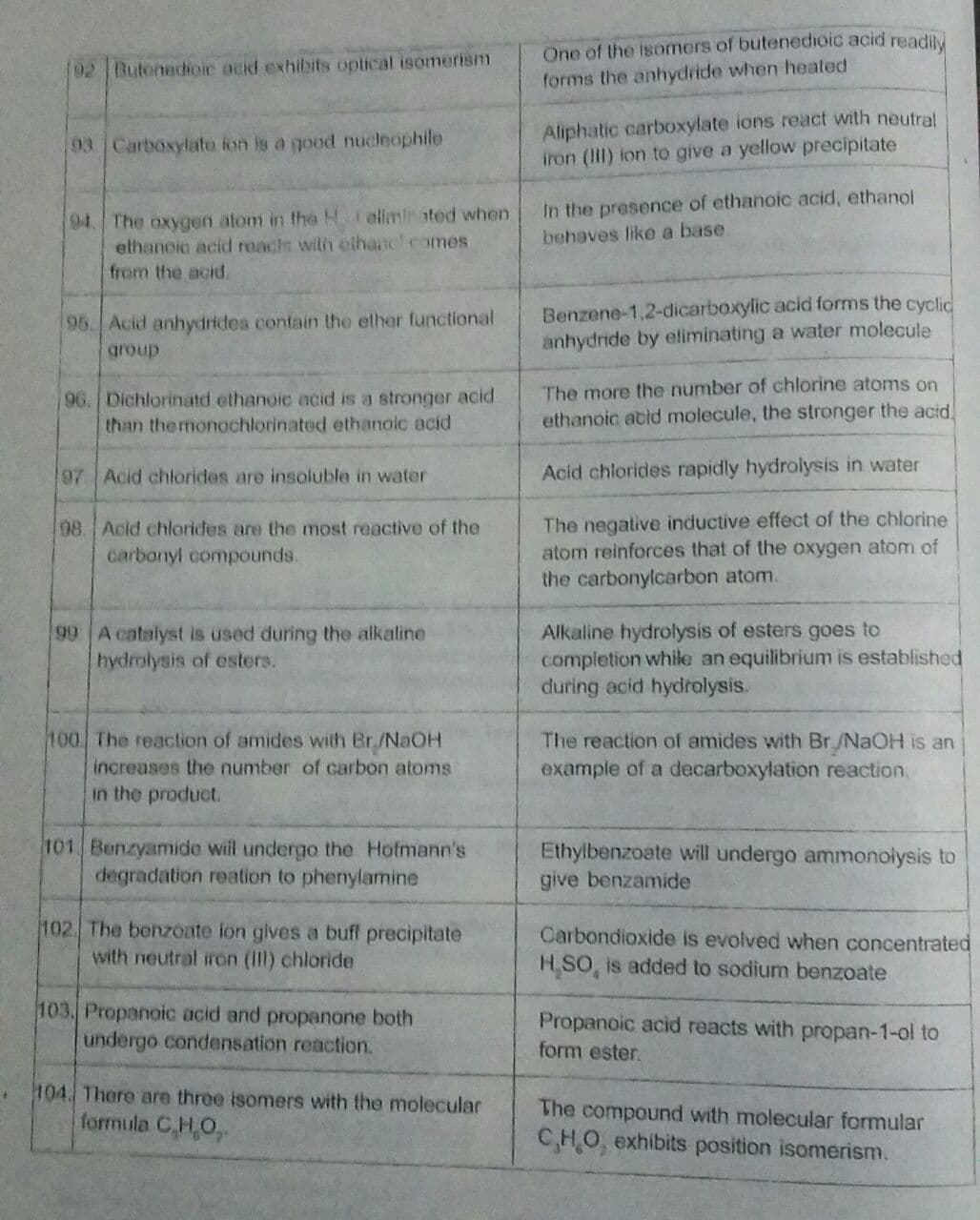100 The reaction of amides with Br./NaOH increases the number of carbon atoms in the product. 101 Benzyamide will undergo the Hofmann's degradation reation to phenylamine 102. The benzoate fon gives a buff precipitate with neutral iron (Ill) chloride
100 The reaction of amides with Br./NaOH increases the number of carbon atoms in the product. 101 Benzyamide will undergo the Hofmann's degradation reation to phenylamine 102. The benzoate fon gives a buff precipitate with neutral iron (Ill) chloride
Chapter22: Carbonyl Alpha-substitution Reactions
Section22.SE: Something Extra
Problem 63AP: As far back as the 16th century, South American Incas chewed the leaves of the coca bush,...
Related questions
Question
Answer Q100, 101, 102

Transcribed Image Text:One of the isomers of butenedioic acid readily
forms the anhydride when heated
92 Butonedioie acid exhibits optical isomerism
Aliphatic carboxylate ions react with neutra!
iron (III) ion to give a yellow precipitate
93 Carboxylate fon is a good nucleophile
94. The oxygen atom in the H elimin ated when
ethanoia acid reach with eihancl comes
from the acid.
In the presence of ethanoic acid, ethanol
behaves like a base
Benzene-1,2-dicarboxylic acid forms the cyclic
anhydride by eliminating a water molecule
95. Acid anhydrides contain the ether functional
group
96. Dichlorinatd ethanoic acid is a stronger acid
than themonochlorinated ethanoic acid
The more the number of chlorine atoms on
ethanoic acid molecule, the stronger the acid.
97 Acid chlorides are insoluble in water
Acid chlorides rapidly hydrolysis in water
The negative inductive effect of the chlorine
atom reinforces that of the oxygen atom of
the carbonylcarbon atom.
98. Acid chlorides are the most reactive of the
carbonyl compounds.
99 A catalyst is used during the alkaline
hydrolysis of esters.
Alkaline hydrolysis of esters goes to
completion while an equilibrium is established
during acid hydrolysis.
100 The reaction of amides with Br./NaOH
increases the number of carbon atoms
The reaction of amides with Br/NAOH is an
example of a decarboxylation reaction,
in the product.
101 Benzyamide will undergo the Hofmann's
degradation reation to phenylamine
Ethylbenzoate will undergo ammonolysis to
give benzamide
102 The benzoate lon glves a buff precipitate
with neutral iron (ill) chloride
Carbondioxide is evolved when concentrated
HSO, is added to sodium benzoate
103. Propanoic acid and propanone both
undergo condensation reaction.
Propanoic acid reacts with propan-1-ol to
form ester.
104. There are three isomers with the molecular
formula C,H,O,
The compound with molecular formular
CHO. exhibits position isomerism.
Expert Solution
This question has been solved!
Explore an expertly crafted, step-by-step solution for a thorough understanding of key concepts.
Step by step
Solved in 3 steps with 3 images

Knowledge Booster
Learn more about
Need a deep-dive on the concept behind this application? Look no further. Learn more about this topic, chemistry and related others by exploring similar questions and additional content below.Recommended textbooks for you


Organic Chemistry
Chemistry
ISBN:
9781305580350
Author:
William H. Brown, Brent L. Iverson, Eric Anslyn, Christopher S. Foote
Publisher:
Cengage Learning


Organic Chemistry
Chemistry
ISBN:
9781305580350
Author:
William H. Brown, Brent L. Iverson, Eric Anslyn, Christopher S. Foote
Publisher:
Cengage Learning